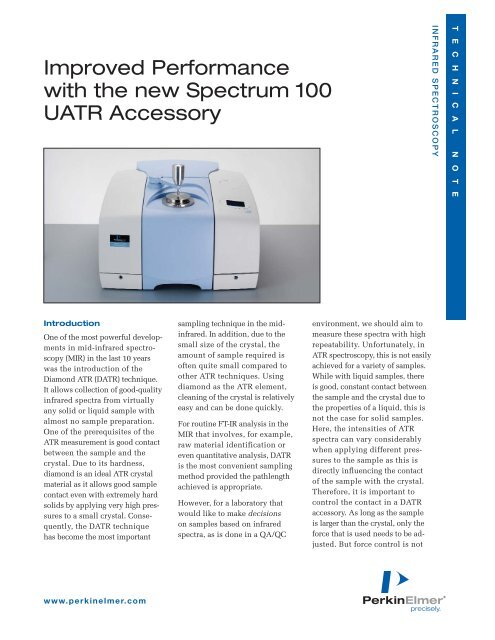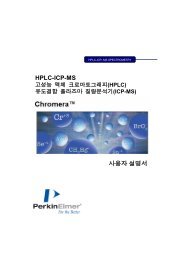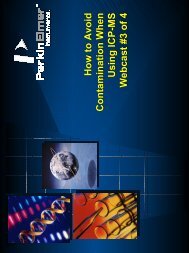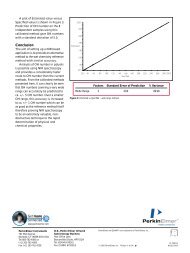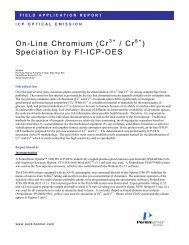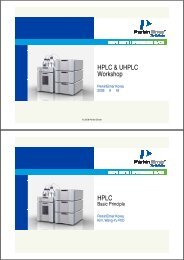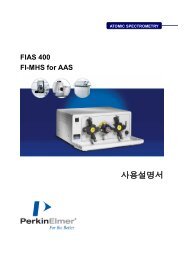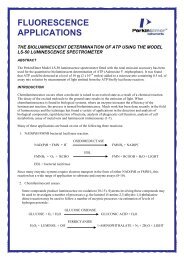Improved Performance with the new Spectrum 100 UATR Accessory
Improved Performance with the new Spectrum 100 UATR Accessory
Improved Performance with the new Spectrum 100 UATR Accessory
You also want an ePaper? Increase the reach of your titles
YUMPU automatically turns print PDFs into web optimized ePapers that Google loves.
<strong>Improved</strong> <strong>Performance</strong><br />
<strong>with</strong> <strong>the</strong> <strong>new</strong> <strong>Spectrum</strong> <strong>100</strong><br />
<strong>UATR</strong> <strong>Accessory</strong><br />
INFRARED SPECTROSCOPY<br />
T E C H N I C A L N O T E<br />
Introduction<br />
One of <strong>the</strong> most powerful developments<br />
in mid-infrared spectroscopy<br />
(MIR) in <strong>the</strong> last 10 years<br />
was <strong>the</strong> introduction of <strong>the</strong><br />
Diamond ATR (DATR) technique.<br />
It allows collection of good-quality<br />
infrared spectra from virtually<br />
any solid or liquid sample <strong>with</strong><br />
almost no sample preparation.<br />
One of <strong>the</strong> prerequisites of <strong>the</strong><br />
ATR measurement is good contact<br />
between <strong>the</strong> sample and <strong>the</strong><br />
crystal. Due to its hardness,<br />
diamond is an ideal ATR crystal<br />
material as it allows good sample<br />
contact even <strong>with</strong> extremely hard<br />
solids by applying very high pressures<br />
to a small crystal. Consequently,<br />
<strong>the</strong> DATR technique<br />
has become <strong>the</strong> most important<br />
sampling technique in <strong>the</strong> midinfrared.<br />
In addition, due to <strong>the</strong><br />
small size of <strong>the</strong> crystal, <strong>the</strong><br />
amount of sample required is<br />
often quite small compared to<br />
o<strong>the</strong>r ATR techniques. Using<br />
diamond as <strong>the</strong> ATR element,<br />
cleaning of <strong>the</strong> crystal is relatively<br />
easy and can be done quickly.<br />
For routine FT-IR analysis in <strong>the</strong><br />
MIR that involves, for example,<br />
raw material identification or<br />
even quantitative analysis, DATR<br />
is <strong>the</strong> most convenient sampling<br />
method provided <strong>the</strong> pathlength<br />
achieved is appropriate.<br />
However, for a laboratory that<br />
would like to make decisions<br />
on samples based on infrared<br />
spectra, as is done in a QA/QC<br />
environment, we should aim to<br />
measure <strong>the</strong>se spectra <strong>with</strong> high<br />
repeatability. Unfortunately, in<br />
ATR spectroscopy, this is not easily<br />
achieved for a variety of samples.<br />
While <strong>with</strong> liquid samples, <strong>the</strong>re<br />
is good, constant contact between<br />
<strong>the</strong> sample and <strong>the</strong> crystal due to<br />
<strong>the</strong> properties of a liquid, this is<br />
not <strong>the</strong> case for solid samples.<br />
Here, <strong>the</strong> intensities of ATR<br />
spectra can vary considerably<br />
when applying different pressures<br />
to <strong>the</strong> sample as this is<br />
directly influencing <strong>the</strong> contact<br />
of <strong>the</strong> sample <strong>with</strong> <strong>the</strong> crystal.<br />
Therefore, it is important to<br />
control <strong>the</strong> contact in a DATR<br />
accessory. As long as <strong>the</strong> sample<br />
is larger than <strong>the</strong> crystal, only <strong>the</strong><br />
force that is used needs to be adjusted.<br />
But force control is not<br />
www.perkinelmer.com
<strong>the</strong> only key to good reproducibility.<br />
There are o<strong>the</strong>r influences from <strong>the</strong><br />
design of a DATR accessory that can<br />
reduce <strong>the</strong> contact and not only give<br />
rise to spectral ordinate variations,<br />
but also to spectral distortions <strong>with</strong><br />
changes of <strong>the</strong> line shape. Therefore,<br />
a careful design of <strong>the</strong> mechanics in<br />
such an accessory is very important<br />
to guarantee good quality spectra.<br />
The <strong>Spectrum</strong> <strong>100</strong><br />
<strong>UATR</strong> <strong>Accessory</strong><br />
The <strong>new</strong> Universal ATR accessory<br />
(<strong>UATR</strong>) for <strong>the</strong> <strong>Spectrum</strong> <strong>100</strong><br />
Spectrometer (Figure 1) is an improved<br />
version of <strong>the</strong> diamond ATR<br />
accessory that was developed for <strong>the</strong><br />
<strong>Spectrum</strong> One spectrometers.<br />
The <strong>new</strong> design of <strong>the</strong> <strong>UATR</strong> enables<br />
higher spectral reproducibility,<br />
signal-to-noise performance and<br />
ease-of-use. Key design enhancements<br />
follow.<br />
Positive locations<br />
of <strong>the</strong> movable arm<br />
The <strong>new</strong> <strong>UATR</strong> accessory for <strong>the</strong><br />
<strong>Spectrum</strong> <strong>100</strong> FT-IR uses a movable<br />
arm that swings in to clamp<br />
<strong>the</strong> sample and moves out to allow<br />
better access to <strong>the</strong> crystal during<br />
cleaning or changing of <strong>the</strong> crystal<br />
plate. This design approach is<br />
common to most DATR accessories.<br />
However, <strong>the</strong>re is always <strong>the</strong> danger<br />
that <strong>the</strong> arm does not adequately<br />
engage <strong>the</strong> sample due to mechanical<br />
tolerances in <strong>the</strong> arm mechanism,<br />
resulting in possible spectral reproducibility<br />
problems. With <strong>the</strong><br />
<strong>new</strong> <strong>UATR</strong> design, this is overcome<br />
by using an arm <strong>with</strong> two positive<br />
locations at <strong>the</strong> end stops that are<br />
permanently aligned, giving <strong>the</strong><br />
user a tactile feeling for <strong>the</strong> correct<br />
position when moving <strong>the</strong> arm to<br />
<strong>the</strong> sampling end stop.<br />
<strong>Improved</strong> rigidity<br />
of <strong>the</strong> movable arm<br />
Ano<strong>the</strong>r source of intensity variations<br />
is related to <strong>the</strong> bending of <strong>the</strong><br />
arm when applying high force to it.<br />
The result of this bending is that <strong>the</strong><br />
surface of <strong>the</strong> pressure shoe is no<br />
longer parallel to <strong>the</strong> crystal surface,<br />
i.e. <strong>the</strong> direction in which <strong>the</strong> force<br />
is applied is no longer perpendicular<br />
to <strong>the</strong> crystal. This has <strong>the</strong> effect that<br />
<strong>the</strong> contact of <strong>the</strong> sample is no<br />
longer uniform over <strong>the</strong> crystal,<br />
resulting in not only a reduced<br />
intensity of <strong>the</strong> spectrum but also<br />
generating additional intensity<br />
variations depending on <strong>the</strong><br />
bending of <strong>the</strong> arm. With <strong>the</strong> <strong>new</strong><br />
design, <strong>the</strong> movable arm is much<br />
more rigid and <strong>the</strong>se bending effects<br />
are totally removed. Figure 2 demonstrates<br />
<strong>the</strong> improved sampling<br />
performance of <strong>the</strong> <strong>new</strong> accessory<br />
based on <strong>the</strong>se design changes. In<br />
order to test <strong>the</strong>se changes, 15 replicate<br />
spectra of <strong>the</strong> same polystyrene<br />
film were measured <strong>with</strong> <strong>the</strong> old<br />
and <strong>the</strong> <strong>new</strong> design <strong>UATR</strong> accessory<br />
(1 bounce) by using <strong>the</strong> 0.5 mm <strong>UATR</strong><br />
shoe and a force gauge of 120 units.<br />
Between each measurement, <strong>the</strong><br />
sample was removed and <strong>the</strong> crystal<br />
cleaned. The top plate was not<br />
changed between samples.<br />
Figure 2 shows <strong>the</strong> strongest band<br />
in <strong>the</strong> polystyrene spectrum of<br />
approximately 695 cm -1 . The left<br />
graph shows <strong>the</strong> band intensity<br />
variation due to <strong>the</strong> lower rigidity<br />
of <strong>the</strong> arm in <strong>the</strong> old accessory.<br />
The largest difference between<br />
<strong>the</strong> absorbance of this polystyrene<br />
band here is 30.8% of <strong>the</strong> average<br />
absorbance. The design improvements<br />
achieved <strong>with</strong> <strong>the</strong> <strong>new</strong><br />
accessory are demonstrated in<br />
<strong>the</strong> right graph where this deviation<br />
is only 3%. In addition to this improved<br />
ordinate reproducibility by<br />
one order of magnitude, an increase<br />
in band intensity by a factor of<br />
Figure 1. <strong>UATR</strong> accessory for <strong>Spectrum</strong> <strong>100</strong>.<br />
Figure 2. Intensity variation of 15 replicate measurements of a poly-styrene film on <strong>the</strong> previous<br />
<strong>UATR</strong> (left) and <strong>the</strong> <strong>new</strong> <strong>UATR</strong> accessory (right).<br />
2
2.5-3.0 can also be observed. It is<br />
important to note that this improved<br />
contact is not achieved through<br />
changing <strong>the</strong> force. With both accessories,<br />
<strong>the</strong> same force was applied,<br />
but <strong>the</strong> sample was pressed more perpendicular<br />
to <strong>the</strong> surface of crystal<br />
<strong>with</strong> <strong>the</strong> <strong>new</strong> <strong>UATR</strong>.<br />
This performance improvement has<br />
been fur<strong>the</strong>r demonstrated using a<br />
powder sample that should show<br />
even larger variations due to different<br />
particle sizes or different packaging.<br />
Figure 3 shows <strong>the</strong> result of 15 replicate<br />
measurements of caffeine<br />
powder <strong>with</strong> <strong>the</strong> previous and<br />
<strong>the</strong> <strong>new</strong> design <strong>UATR</strong> accessory<br />
(1 bounce) by using <strong>the</strong> 0.5 mm<br />
<strong>UATR</strong> shoe, <strong>the</strong> <strong>UATR</strong> Sample<br />
position plate 3 mm diameter and<br />
a force gauge reading of <strong>100</strong> units.<br />
Between each measurement, <strong>the</strong><br />
sample was removed and <strong>the</strong> crystal<br />
cleaned. The top plate was not<br />
changed between samples.<br />
As expected, <strong>the</strong> enhanced repeatability<br />
of <strong>the</strong> <strong>new</strong> design is clearly<br />
proven in <strong>the</strong> right graph <strong>with</strong> less<br />
absorbance variations of one of<br />
<strong>the</strong> strong caffeine bands around<br />
742 cm -1 , but also <strong>with</strong> less variations<br />
in <strong>the</strong> baseline. The improved<br />
uniformity of <strong>the</strong> pressure of this<br />
powder sample can be observed<br />
during cleaning of <strong>the</strong> crystal. With<br />
<strong>the</strong> <strong>new</strong> accessory, <strong>the</strong> compacted<br />
powder was covering <strong>the</strong> whole<br />
crystal, while on <strong>the</strong> old accessory,<br />
only half of <strong>the</strong> powder on <strong>the</strong> crystal<br />
was compacted. In addition, we<br />
observe increased intensities and<br />
<strong>the</strong>refore an improved signal-tonoise<br />
performance compared to <strong>the</strong><br />
old design. This performance gain<br />
could be used to allow a shorter<br />
measurement time and, <strong>the</strong>refore,<br />
a higher sample throughput.<br />
One could argue that <strong>the</strong>se kind<br />
of variations observed are not so<br />
critical in qualitative analysis; for<br />
example, in <strong>the</strong> identification of a<br />
raw material by doing a COMPARE<br />
of <strong>the</strong> sample spectrum against a<br />
reference spectrum. Due to <strong>the</strong> filters<br />
applied in <strong>the</strong> COMPARE algorithm,<br />
<strong>the</strong>se variations are reduced and still<br />
allow <strong>the</strong> discrimination between<br />
samples that have quite different<br />
infrared spectra. However, <strong>with</strong><br />
<strong>the</strong>se variations, more subtle<br />
changes of <strong>the</strong> line shape of bands<br />
can also occur that can make it<br />
difficult to discriminate materials<br />
<strong>with</strong> very similar spectra – especially<br />
if we use chemometric methods.<br />
Kinematic mount<br />
of <strong>the</strong> top plate<br />
Ano<strong>the</strong>r source of variation <strong>with</strong><br />
some DATR accessories is due to<br />
changes of <strong>the</strong> beam geometry when<br />
exchanging <strong>the</strong> top plate. With <strong>the</strong><br />
<strong>new</strong> accessory design, this is overcome<br />
by using a kinematic mount<br />
that ensures that <strong>the</strong> top plate is<br />
always in <strong>the</strong> same position independent<br />
of how often <strong>the</strong> top plate<br />
is touched, removed and put back.<br />
In order to demonstrate <strong>the</strong> improvement<br />
in repeatability achieved<br />
<strong>with</strong> this <strong>new</strong> design, an experiment<br />
was chosen where any variation due<br />
to sample contact was excluded by<br />
using a liquid sample (Nujol). Fifteen<br />
replicate spectra were measured,<br />
and in between each measurement,<br />
<strong>the</strong> top plate was cleaned, removed<br />
and put back. A background was<br />
only measured once at <strong>the</strong> beginning<br />
of <strong>the</strong> experiment. Figure 4<br />
highlights <strong>the</strong> improved stability of<br />
<strong>the</strong> beam geometry <strong>with</strong> <strong>the</strong> kinematic<br />
mount. With <strong>the</strong> old design,<br />
<strong>the</strong> variation of <strong>the</strong> transmittance of<br />
<strong>the</strong> strongest Nujol band is 0.32 %T,<br />
while <strong>with</strong> <strong>the</strong> kinematic mount,<br />
this is reduced to 0.084 %T. At <strong>the</strong><br />
baseline of <strong>the</strong> Nujol spectrum<br />
(1800 cm -1 ), <strong>the</strong> corresponding variations<br />
are 0.606 %T and 0.0821 %T.<br />
Figure 3. Intensity variation of 15 replicate measurements of a Caffeine<br />
powder sample <strong>with</strong> <strong>the</strong> previous (left) and <strong>the</strong> <strong>new</strong> (right) <strong>UATR</strong><br />
accessory.<br />
Figure 4. Transmittance variation of 15 replicate measurements<br />
of a Nujol sample when changing <strong>the</strong> top plate in between <strong>with</strong><br />
<strong>the</strong> previous (left) and <strong>the</strong> <strong>new</strong> (right) <strong>UATR</strong> accessory.<br />
www.perkinelmer.com<br />
3
This kinematic mount does not only<br />
reduce baseline effects (that could<br />
be largely removed by applying an<br />
offset correction); it also prevents<br />
<strong>the</strong> situation where <strong>the</strong> beam is<br />
passed through different parts of <strong>the</strong><br />
ATR crystal, helping to avoid small<br />
changes of <strong>the</strong> line shapes of <strong>the</strong><br />
sample bands.<br />
In order to compare <strong>the</strong>se results<br />
<strong>with</strong> a competitive DATR accessory,<br />
<strong>the</strong> previous experiment was repeated<br />
<strong>with</strong> a third party DATR<br />
accessory, where <strong>the</strong> top plate was<br />
not removed but <strong>the</strong> crystal was<br />
cleaned between each sample and<br />
<strong>the</strong> bridge closed and screwed down.<br />
In Figure 5, <strong>the</strong> spectra are displayed.<br />
The mounting of <strong>the</strong> third party accessory<br />
crystal is obviously very<br />
sensitive to touching – <strong>the</strong> cleaning<br />
of <strong>the</strong> crystal is generating a big<br />
variation of <strong>the</strong> beam geometry<br />
resulting in strong transmittance<br />
changes. Here <strong>the</strong> variation of <strong>the</strong><br />
transmittance is 2.89 %T at <strong>the</strong><br />
strongest Nujol band and 4.17 %T<br />
at <strong>the</strong> baseline of <strong>the</strong> Nujol spectrum<br />
(1800 cm -1 ). In addition, <strong>the</strong>re is a<br />
distortion observed of <strong>the</strong> Nujol<br />
spectra at <strong>the</strong> baseline.<br />
Force restrictor<br />
In <strong>the</strong> <strong>new</strong> design, <strong>the</strong> head of <strong>the</strong><br />
screw that is used to apply pressure<br />
to a sample contains a built-in slipping<br />
clutch that works as a force<br />
restrictor. So, in addition to <strong>the</strong><br />
force gauge in <strong>the</strong> software which<br />
changes its color to red when <strong>the</strong><br />
maximum force is reached, this device<br />
fur<strong>the</strong>r prevents any damage<br />
of <strong>the</strong> crystal due to overpressure.<br />
<strong>Improved</strong> sealing<br />
of <strong>the</strong> top plate<br />
The <strong>new</strong> <strong>UATR</strong> accessory now has<br />
a seal between <strong>the</strong> top plate and <strong>the</strong><br />
upper part of <strong>the</strong> accessory body.<br />
This sealing prevents solvent vapors<br />
generated during cleaning from diffusing<br />
into <strong>the</strong> beam. With some<br />
designs, this is sometimes observed<br />
as additional solvent bands in <strong>the</strong><br />
sample spectra.<br />
Summary<br />
These results show that <strong>the</strong><br />
design of a DATR accessory<br />
strongly influences <strong>the</strong> spectral<br />
quality. With its improved design,<br />
<strong>the</strong> <strong>new</strong> <strong>UATR</strong> accessory for <strong>the</strong><br />
<strong>Spectrum</strong> <strong>100</strong> is capable of generating<br />
spectra <strong>with</strong> an improved<br />
ordinate repeatability by up to<br />
one order of magnitude and an<br />
improved signal-to-noise by a<br />
factor of 3 compared to <strong>the</strong> previous<br />
version. Therefore, it is<br />
predestined for routine applications<br />
where <strong>the</strong>se benefits will<br />
allow higher sample throughput<br />
or improved quality of <strong>the</strong> results<br />
achieved.<br />
Figure 5. 15 replicate measurements of a Nujol sample <strong>with</strong> <strong>the</strong> Golden Gate accessory (left) and<br />
<strong>the</strong> <strong>new</strong> <strong>UATR</strong> accessory (right).<br />
PerkinElmer Life and<br />
Analytical Sciences<br />
710 Bridgeport Avenue<br />
Shelton, CT 06484-4794 USA<br />
Phone: (800) 762-4000 or<br />
(+1) 203-925-4602<br />
www.perkinelmer.com<br />
For a complete listing of our global offices, visit www.perkinelmer.com/lasoffices<br />
©2005 PerkinElmer, Inc. All rights reserved. The PerkinElmer logo and design are registered trademarks of PerkinElmer, Inc. COMPARE and <strong>Spectrum</strong> are trademarks of PerkinElmer, Inc. or<br />
its subsidiaries, in <strong>the</strong> United States and o<strong>the</strong>r countries. All o<strong>the</strong>r trademarks not owned by PerkinElmer, Inc. or its subsidiaries that are depicted herein are <strong>the</strong> property of <strong>the</strong>ir respective<br />
owners. PerkinElmer reserves <strong>the</strong> right to change this document at any time <strong>with</strong>out notice and disclaims liability for editorial, pictorial or typographical errors.<br />
007457_10 Printed in USA


